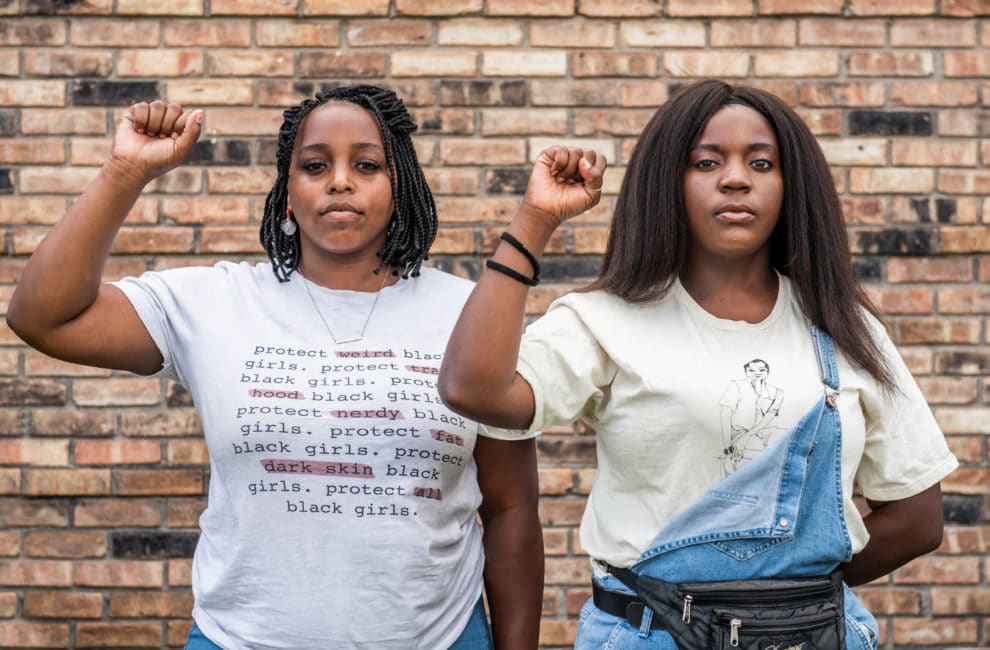10 Things To Know About Indy10 Black Lives Matter

Kyra Harvey, left, and Leah Derray are the leaders of Indy10 Black Lives Matter. Photo by Ted Somerville
Talk about tireless—Leah Derray and Kyra Harvey, leaders of Indy10 Black Lives Matter, have been protesting full-throttle for six years now. They’re not done yet.
First, there were 10. Indy10 Black Lives Matter was founded by a group of strangers in 2014. They traveled to Ferguson, Missouri, to protest the fatal shooting of Michael Brown, a black man, by police. Of the original 10, only Leah Derray remains, joined by childhood friend Kyra Harvey, who came on board soon after Ferguson and now co-leads with Derray.
For these women, activism is their calling. Derray and Harvey also work for the Kheprw Institute and The Bail Project, both community activism organizations.

Kyra Harvey, one of the leaders of Indy10 Black Lives Matter.Photo by Ted Somerville
The incarceration of her father and brothers inspired Harvey to fight for change. Black male incarceration rates have left a void in their community, they say, often filled by women who see the need to step up and take care of business. On the other hand, Derray says, an established patriarchy can act as a barrier to change, adding to the burden carried by black women.
Six years since Ferguson, the pair say they’re more hopeful than tired. Both 29 years old, they appreciate the newer activists—many of them friends of Dreasjon Reed who was killed by IMPD in May—for invigorating their spirits.
Younger protesters are keeping them going. “For a while there I was like, Damn, you know? I’m tired. I kind of just want to live a life,” Derray says. “But you know, black people aren’t afforded that luxury to just live their lives. So, all these young people who got activated by the passing of their friend, they kind of lit a fire under us, like OK, we’ll still continue this work and we can also pour into people, and at the same time, they can pour into us.”
Activism is about doing the boring work, too. Indy10 BLM maintains a presence in the community beyond what makes the headlines. The group works for overall black wellness through food pantries, self-defense classes, self-love events, and a mental-health task force. Derray and Harvey meet often with city councilors, such as Councilman Ethan Evans, himself a former Indy10 BLM member, and local leaders, bringing younger members with them to show another side of organizing community change.
Because getting it done isn’t always glamorous. “We tell (younger members) we can protest, but we also got to do this, too,” Harvey says. “OK, we’re talking about defunding the police, so what does that look like? We need to actually meet with lawmakers and people who can pass those laws so we can get stuff like that done.”

Leah Derray, one of the leaders of Indy10 Black Lives Matter.Photo by Ted Somerville
It’s not about the glory. Derray and Harvey aren’t always seen out front, starting chants or leading marches. They let others take those positions. “We try to make sure the young people know that this movement isn’t about the individual. It’s not about the shine, because anybody can purchase a bullhorn from Amazon. It’s about, ‘What are you saying when that spotlight is on you?’” Derray says.
Indy10 BLM has “accomplices” in its work. It partners with like-minded organizations, such as Queering Indy and Indy SURJ (Showing Up for Racial Justice), to give other demographic groups a way to aid the movement.
There’s one way the climate is different since Ferguson. Derray sees a more welcoming atmosphere to the intersectionality of LGBTQ issues. “We’re all-inclusive for all black people, no matter your socio-economic status, no matter your religious background. As long as you’re coming, you’re open, you’re willing to unlearn some of the things that have been ingrained into us, then you’re welcome.”





